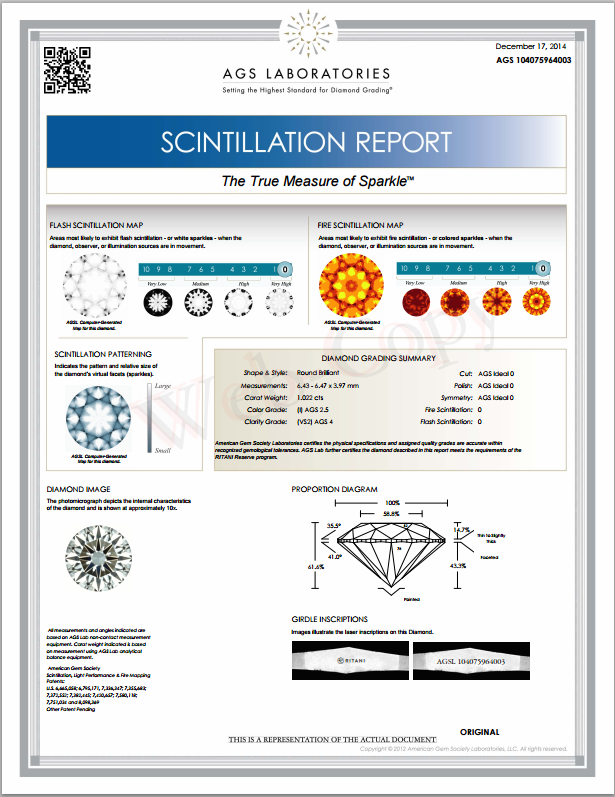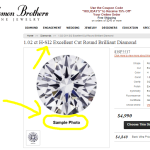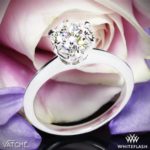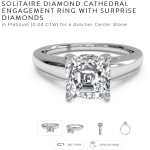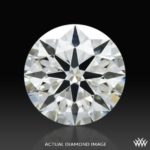What Makes A Diamond Sparkle? Understanding Diamond Scintillation
Everyone knows that diamonds are the ‘go-to-gem’ for engagement rings and fine jewelry. They are the hardest natural material on earth which makes them particularly sought after for their durability and stability. Their hardness allows for them to be polished to a high adamantine luster which is extremely bright and reflective. But all of this doesn’t really tell us what we really want to know – exactly what makes a diamond sparkle? What exactly is diamond scintillation?
The sparkle of a diamond is known as a dynamic characteristic; meaning you must physically move the diamond in order to see how light dances through the facets and across the crown. The sparkle of a diamond is called ‘scintillation’ and it is a product of both brilliance (white light reflection) and dispersion (rainbow of colors aka fire).
What Is Diamond Scintillation aka Diamond Sparkle?
Nature provides the crystal but humans provide the sparkle. Therefore, a diamond only comes to life after it has been cut and polished. Sparkles are a product of cut (proportions, facet alignment, polish and symmetry), where light enters a diamond from many different angles and is internally refracted and reflected back through the crown to your eyes where you visually appreciate it’s sparkling beauty. Through ongoing research, AGS has determined that sparkle/scintillation in a diamond is a result of:
- ‘flash scintillation’ – dynamic pattern of white sparkles observed across a diamond’s crown
- ‘fire scintillation’ – dynamic pattern of colored sparkles observed across a diamond’s crown
Together these two aspects of diamond scintillation appear visually as either a) few big and bright flashes or numerous tiny and less luminous flashes of light. Diamonds can have evenly distributed sparkles or have them localized and dominant in one area. So what determines the size, amount, distribution, and quality (flash vs. fire) of sparkle?
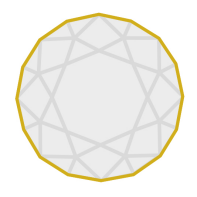 If you can image a diamond’s crown view, you will see a table facet, surrounded by eight star facets, eight kite facets, and 16 upper girdle facets. This is easy to understand via the image to the right. However, when you look at a diamond you’ve definitely seen thousands of tiny geometric shapes that seem to flash into existence as you move the diamond back and forth. These flashes are referred to as ‘virtual facets’ and they create a living mosaic of a diamond’s sparkle profile. They are essentially mirror reflections of light created from the original 57 facets of a normal round brilliant diamond. AGS has done extensive research into this and has concluded that the size and distribution of virtual facets have a direct impact on a diamond’s sparkle.
If you can image a diamond’s crown view, you will see a table facet, surrounded by eight star facets, eight kite facets, and 16 upper girdle facets. This is easy to understand via the image to the right. However, when you look at a diamond you’ve definitely seen thousands of tiny geometric shapes that seem to flash into existence as you move the diamond back and forth. These flashes are referred to as ‘virtual facets’ and they create a living mosaic of a diamond’s sparkle profile. They are essentially mirror reflections of light created from the original 57 facets of a normal round brilliant diamond. AGS has done extensive research into this and has concluded that the size and distribution of virtual facets have a direct impact on a diamond’s sparkle.
The more facets a diamond has, the more virtual facets will be reflected, however this doesn’t necessarily mean that diamonds with more facets have a more attractive sparkle profile. AGS has determined that scintillation that is evenly distributed to the fullest extent possible with the largest flashes of alternating white and color flashes would be considered the most visually appealing. These diamonds exhibit sparkle across the full crown of the stone; taking full advantage of light from many different sources, under a broad range of movement, and show minimal underperforming (dead) areas. Therefore, one can say that the virtual facets must adhere to an evenly distributed scintillation pattern that includes a balanced mix of sparkle size, amount, distribution and quality. The key word is balance.
- More facets = more virtual facets = Numerous tiny, faint flashes of light and color
- Less facets = less virtual facets = Fewer bigger, bolder flashes of light and color
- Scintillation Patterning = the pattern and relative size of the diamond’s sparkle, whether flash or fire scintillation
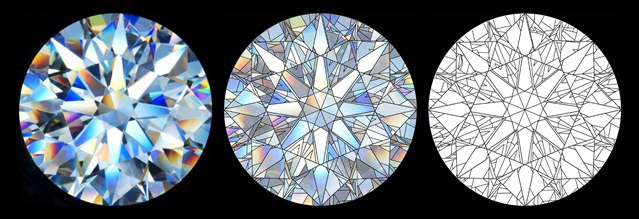
Visual depiction of virtual facets. Photograph and illustration by Jim Caudill, AGS as published by Rapaport Magazine.
How Do You Measure The ‘Sparkle Factor’?
Scintillation performance is not to be confused with light performance or more commonly evaluated through an ASET. An ASET image is a static image of a diamond in broad diffuse lighting that cannot successfully demonstrate the dynamic display of light scintillation. Sparkle is strictly a product of movement. Since sparkle or scintillation is a dynamic characteristic, how does a consumer effectively evaluate this characteristic via the internet? Since the science of evaluating a diamond’s scintillation or sparkle is still a work in progress, we can evaluate what currently exists and see how each method compares to one another.
AGS Lab’s ‘The Scintillation Report’ –
This unique report features maps and metrics related to flash scintillation, fire scintillation, and scintillation patterning. You may wonder how AGS can create a static image of these dynamic characteristics of a diamond? Well, AGS takes a 3-D model of a diamond (using ray tracing technology) and creates a multitude of various images from different orientations to create a series of color coded maps. These maps are then averaged and overlaid to create one comprehensive map. The Scintillation Report includes a: Flash Scintillation Map, Fire Scintillation Map and a Scintillation Patterning Map. These Scintillation Maps represent the change in illumination of a diamond’s crown and helps to convey information about the the size and form of the virtual facets as well easy easily quantifying sparkle. This report further certifies that that the diamond described on the accompanying AGS report meets the requirements of the Ritani Reserve Program, however it is unknown what these requirements are. Also, please let it be known that these diamonds are not considered super-ideal hearts and arrows diamonds.
Sarine’s ‘Diamond Light Performance Report’ –
Sarine Technologies are engaged in developing, manufacturing, marketing and selling precision technology products for processing of diamonds and gemstones. Their Sarine Light Report measures and grades a diamond’s actual measurements, color grade, and clarity (inclusions) to produce separate calculations for brilliance, sparkle, fire, and light symmetry for a total light performance grade. Sarine’s light performance grading scale includes: Ultimate (3, 2, and 1 star), Premium (2 and 1 star), Classic (2 and 1 star) and Low (2 and 1 star).
Consumers can use this report as an added evaluation tool that some online diamond retailers provide. See below for an example of Sarine’s Light Report:
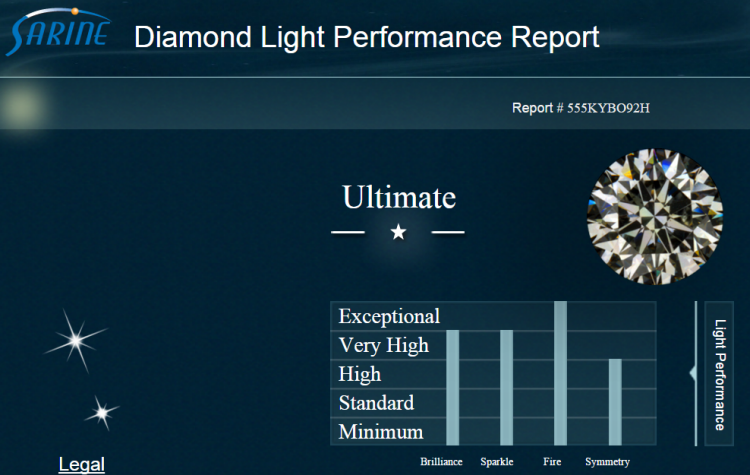
However, it must be stated once again that these diamonds are not to be confused with super-ideal hearts and arrows diamonds.
Understanding Hearts And Arrows In Relation To A Diamond’s ‘Virtual Facets’ & Resulting ‘Sparkle Factor’
As you have already learned, there is a direct relationship between a diamond’s virtual facets and it’s resulting sparkle factor. Though technology continues to innovate with the aim to create tools for fast and easy light performance and sparkle evaluation, there is still some tweaking that can be done to this process. Until then, we must consider a tried and true evaluation method that remains consistent and predictable with regard to light performance and sparkle, and that is the classic hearts and arrows optical symmetry of what are deemed ‘super-ideal’ diamonds.
Perhaps the most reliable way to determine whether a round brilliant ideal cut diamond is going to exhibit maximum visual performance and “sparkle factor” is to look for a crisp and complete pattern of symmetrical hearts and arrows. This pattern combined with select AGS Ideal 0 cut proportions (not all AGS higher performance/ideal cut grade diamonds will be show this pattern) will ellicit a higher number of virtual facets that result in larger flashes of overall brilliance and dispersion. The key factor is consistency in cut grade allowing for superior overall light performance and scintillation patterning with a focus on equal balancing of flash and fire scintillation.
Where To Buy Sparkling Diamonds
For consumers looking for diamonds exhibiting this extremely rare and consistent combination of bright light reflection, perfect optical symmetry (contrast), and perfect balance of virtual facets, the most consistent H&A brands include Whiteflash and Brian Gavin Diamonds. Diamonds in this category are exceedingly rare and painstakingly evaluated for perfection among all the nuances of diamond beauty.For more information on his Whiteflash’s ‘A Cut Above’ Diamonds, please read ODBA’s Whiteflash Review. For more information on Brian’s ‘Signature’ brand of H&A diamonds, please read ODBA’s BGD Review.
Diamond sparkle is a simple concept but a complex science. Our eyes tell us what we deem beautiful but trying to qualify these characteristics is like trying to capture the movement of a morning sun-rise or the warmth of a loved one’s smile. Perhaps that is why we find such great value in them – they simply cannot be measured or packaged. Scientific formulas may bring us close, but ultimately we must accept that beauty like this can be most appreciated in the intangible. Thus, we must do our best using the tools available to try and get an accurate picture of a diamond’s overall beauty and in the end rely on what our eyes and ultimately heart tells us.
If you have any questions about diamond scintillation or sparkle, brilliance, fire/dispersion please contact me with any questions. I look forward to hearing from you!
Happy Diamond Buying!
Hey.You Want Ideal Cut Diamonds?
You've got it.
Join ODBA's Diamond Deal Friday and get handpicked diamonds every week from me to you.
No consultation required. Subscribe now!
ODBA Recommends
You May Also Like

